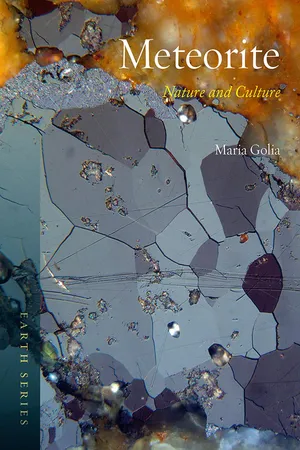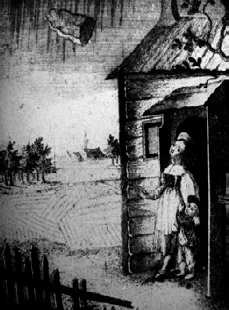![]()
1 Alpha and Omega
On a December afternoon in 1795, seventeen-year-old farmhand John Shipley was going about his business in the sodden, silent hills of Wold Cottage in Yorkshire when the tranquil scene was shattered by explosions ‘like the report of a distant cannon’. Shipley saw something hurtling towards his head that a split second later crashed metres away from his feet, splattering him with stinging shrapnel of cold mud. Two workmates rushed to the side of the dumbfounded young man who, having recovered from his ‘extreme Alarm’, reported ‘that the clouds opened as [the stone] fell and he thought heaven and earth were coming together’.1
And so they had. The 25.4-kg mass that had wedged itself into the chalky soil was a piece of an asteroid, by today’s classifications a chondrite (stony meteorite), one of the most common types. Among most scientists in Shipley’s day the very notion of stones falling from the sky was infra dig and eyewitness accounts like Shipley’s describing similar events, however consistent in their details, were typically dismissed as the maunderings of credulous peasants. Even Shipley could scarcely believe what he had seen. Later he would note that he had ‘ploughed over that very ground last year’, as if it had somehow betrayed him.2
The history of meteoritics, which began in earnest around the time of the Wold Cottage fall, may be understood as an epic journey into the anomalous. The learned men who first embarked on it subscribed to the Enlightenment ideal of objectively pursuing knowledge but their conventional wisdoms had first to be wrenched from their confident grasp. The politics of ideas, religious bias and the difficulty of having to theorize on the basis of second-hand observations conspired to make the reality of falling stones, not to mention their cosmic origin, barely conceivable to the new men of science. Galileo noted that ‘the authority of thousands counts for nothing before the single voice speaking the truth’, but that depends largely on whose voice it happens to be. Laymen’s reports of falling stones were discredited and scientists willing to believe them, obtain samples of the stones or entertain a probable cause for the phenomena were constricted in their thinking by the power of prevailing opinions.
| The earliest surviving meteorite seen landing in the UK fell at Wold Cottage, Yorkshire. Landowner Edward Topham erected this monument to mark the site in 1799: ‘Here, On this Spot, Decr. 13th, 1795 Fell from the Atmosphere AN EXTRAORDINARY STONE’. Oil painting by George Nicholson, 1812. |
German print dated 1769 depicting the Mauerkirchen meteorite fall of 20 November 1768.
When a fireball exploded over Barbotan in the south of France in 1790, producing a shower of stones, teacher and naturalist Jean F. B. de Saint-Amans asked for official testimonies, expecting none to be forthcoming. He instead received a signed affidavit from a mayor of one of the affected towns, including the depositions of 300 witnesses. Saint-Amans shared it with his friend Pierre Bertholon, editor of the Journal des Sciences utile in Montpellier, who published the affidavit not as a testimony to the event but a lament that so many of his countrymen had yet to awaken to the Age of Reason:
How sad, is it not, to see a whole municipality attempt to certify the truth of folk tales . . . the philosophical reader will draw his own conclusions regarding this document, which attests to an apparently false fact, a physically impossible phenomenon.3
In a footnote accompanying excerpts of a paper by physics professor Nicolas Baudin, who witnessed the Barbotan fall, the editors of the journal La Décade attributed the rocky showers to a kind of mass hysteria:
The noise that these meteors make in bursting, the dazzling light that they spread, the surprising shock they cause, stuns the majority of those who see them: they do not doubt that the burst had fallen all around them; they run, they look, and if they find, by chance, some little bit of black stone, surely this stone just fell. As the fable spreads, people all over the countryside search for stones and find thousands of them.4
For the study of meteorites to begin, their existence had first to be acknowledged, or rather re-acknowledged, since falling stones had been documented throughout antiquity and their possible cosmic origin proposed in the fifth century BC. Science is marked by reversals in thinking and discoveries that defy previous definitions of the natural world. But rather than an advanced theory or mathematical proposition, the birth of meteoritics demanded a return, along a zigzag path, to common sense.
The Royal Society of London, established in 1660 at the avant-garde of the Enlightenment, chose for its motto Nullius in verba (‘take nobody’s word for it’) signalling its founders’ intention to establish facts via experiments and objective science. In certain matters, however, you had to take somebody’s word and who better than Sir Isaac Newton, who served as the Royal Society’s president from 1703 until his death in 1727 and whose Principia (1687) had expounded the laws of motion and gravity. Newton’s orderly universe was the home of ‘great bodies, Fixed Stars, planets and Comets’ but there were no odd bits flying about. ‘To make way for the regular and lasting Motions of the planets and Comets, it is necessary to empty the Heavens of all Matter.’5 Like other scientists of his time, Newton saw a higher power in nature’s workings:
This most beautiful system of the sun, planets, and comets, could only proceed from the counsel and dominion of an intelligent and powerful Being . . . This Being governs all things, not as the soul of the world, but as Lord over all.6
Also like his contemporaries, Newton held ancient thinkers, especially Aristotle (384–322 BC), in deep regard. Aristotle’s Meteorologica, a treatise on the Earth and its surroundings, maintained that solid bodies other than the sun, moon and planets could not exist in space, a theory congenial to the Christian belief in God’s perfect creation held by Newton. According to Aristotle, comets originated between the Earth and moon, and meteors were earth’s ‘exhalations’. As for meteorites, commenting upon the stone that had fallen at Aegospotami in Thrace (today’s Gallipoli Peninsula) in around 469–467 BC, Aristotle claimed it was a terrestrial rock, lifted by strong winds, then fallen back to earth.7
Aristotle depicted in the Nuremberg Chronicle (1493).
The Aristotelian tradition of comprehending the world through observation and searching for ‘natural’ circumstances through reasoning would eventually ripen into empirical methodologies. But the belief meanwhile lingered that rare events contradicting theoretical models were aberrations, revealing nothing of nature as it ‘naturally’ functions, and therefore unworthy of investigation. As Francis Bacon remarked in Novum Organum (1620), ‘the human understanding is, of its own nature, prone to suppose the existence of more order and regularity in the world than it finds’. In the late eighteenth century reports of unruly stones were growing too frequent to be dismissed, but few minds were prepared to embrace the degree of disorder required to explain them. William Herschel’s discovery of Uranus in 1781 had nonetheless proved that space held some surprises. The planet had been sighted repeatedly over the previous century but was identified as a comet in keeping with accepted knowledge.8 Some of those willing to entertain the notion that stones did fall maintained, like Aristotle, that they had been somehow thrust into the air, possibly by volcanic activity, yet no one ever saw them going up, only coming down.
The year before the Wold Cottage fall in 1794, a stone that fell at Coscona near Siena compelled Abbé Ambrogio Soldani, a mathematics professor at Siena University, to publish a paper with eyewitness reports and drawings of the stones, concluding they were indeed real and had congealed in the atmosphere. Soldani presented his correspondence with Naples-based mineralogist Guglielmo Thomson, to whom he had sent a sample. Thomson described the stone’s black fusion crust and ‘quartose’ interior speckled with grains of pyrite. The iron component of the stone proved strangely pliant, considering it appeared to have cooled from a molten state and should have therefore been quite brittle. The stone, in short, was different from known terrestrial rocks and Thomson agreed it had formed in the ‘high fiery cloud’ that was seen approaching Coscona when it fell.9
Aristotle’s theory that all things on Earth originate with it or in its atmosphere accommodated the possibility that falling stones were ‘exhalations’ of gas and dust that had somehow solidified. In On the Nature of Things, the Roman poet and philosopher Lucretius (fl. first century BC) expressed ideas about Earth’s atmosphere and the likelihood of masses forming there that had long been accepted:
For whatever ebbs from things is all borne always into the great sea of air; and unless it in return were to give back bodies to things and to recruit them as they ebb, all things ere now would have been dissolved and changed into air.10
The Persian polymath Avicenna (980–1037) described falls of stones and irons that he believed were formed in the atmosphere. René Descartes (1596–1650) likewise argued that lightning can make atmospheric dust turn to stone. Benjamin Franklin’s demonstrations of lightning bolts conducting electricity (published in 1754) lent credence to this idea. Antoine-Laurent de Lavoisier, author of the seminal Elementary Treatise on Chemistry (1789), endorsed the theory that falling stones were formed by lightning in Earth’s atmosphere, as did other influential authorities.11
Abbé Andreas Xaver Stütz was the assistant director of the Imperial Natural History Collection at Vienna. Stütz’s paper of 1790, ‘On Some Stones Allegedly Fallen from Heaven’, set out to debunk the notion of a ‘heavenly’ origin based on reports and samples of three falls (recorded in 1751, 1753 and 1785).
it was said that the iron fell from heaven. It may have been possible for even the most enlightened minds in Germany to have believed such things in 1751 due to the terrible ignorance then prevailing of natural history and practical physics; but in our time it would be unpardonable to regard such fairy tales as likely.12
Recent ...



